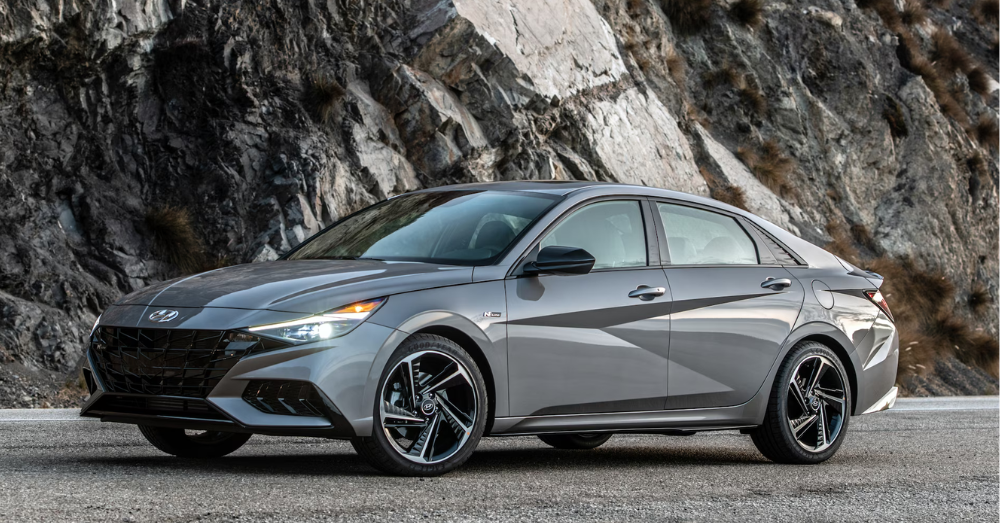Hyundai’s compact Elantra has been around for a few decades and has seen several updates and changes. Let’s take a quick look at the generational history of the Hyundai Elantra, and see why it remains among the most popular used cars to buy.
7 Generations of Efficiency
First Generation (1990-1994)
Hyundai first launched the Elantra in 1990, replacing the poor-performing Hyundai Stellar. Designed to compete with established compacts like the Ford Escort and Chevrolet Cavalier, the little Elantra had its work cut out for it. Powering the Elantra was a Mitsubishi 1.6-liter I4, with a standard manual transmission or optional automatic. Hyundai gave the Elantra a facelift for the 1993 model year, along with a more powerful 1.8-liter Mitsubishi I4.
Second Generation (1995-1999)
The second generation saw the Elantra gain a station wagon version along with a pair of new engines, a 1.5-liter I4 and a 1.8-liter I4. The second generation was given a facelift in 1998 and received a new 2.0-liter I4 engine option. A 1.9-liter diesel motor was offered in European markets to help conform with new European Union emissions standards.
Third Generation (2000-2005)
The Elantra saw a surge in popularity starting with its third generation. Front and front-side airbags were now standard equipment, drastically increasing occupant safety. Only a 2.0-liter I4 was available for third-gen Elantras. To simplify dealer inventories, all United States-bound Elantras received power locks, power windows, air conditioning, and power steering. The Elantra GT came out in 2001 featuring stiffer suspension, leather, alloy wheels, and a spoiler. A facelift came along in 2004, with the major change being the rear-end design.
Fourth Generation (2006-2009)
Hyundai released the fourth-gen Elantra in 2006, featuring “coke bottle styling” meaning a narrow body with flared fenders. 1.6-liter and 2.0-liter I4 engines were offered, along with a new CVT transmission and a five-speed manual. Safety took precedence once again with the Elantra earning an overall Good rating from the IIHS, no small feat for a compact. Trims offered were GLS and SE, along with a Limited trim which was dropped in 2008. No facelift was given for the fourth-generation Elantra.
Fifth Generation (2010-2015)
2010 saw the fifth-gen Elantra’s introduction. A complete design modernization was undertaken, and Hyundai saw immediate sales increases. A new 1.8-liter I4 engine was introduced, along with either a six-speed auto or manual transmission. The CVT automatic from gen-four was dropped. Gen-five saw only two trim levels, GLS and Limited. A facelift occurred in 2014, seeing a slight change in design and the GLS trim’s name changing to SE.
Sixth Generation (2016-2020)
A new sloping fastback-inspired design debuted with the sixth-gen Elantra. The Elantra also underwent a growth spurt, now being classified as a mid-size sedan by the EPA. A 2.0-liter I4 engine was standard except on the new ECO Trim, which received a smaller 1.4-liter turbocharged motor. The Elantra Sport debuted in 2017, receiving a unique 1.6-liter turbocharged motor. No facelift was given in the US market for the sixth-gen.
Seventh Generation (2021-Present)
Presently, the Elantra is in its seventh generation. A radical new design, the Elantra received a larger sports sedan-inspired look. A myriad of safety features came along under Hyundai’s Smart Sense safety feature umbrella. Elantra won North American Car of the Year in 2021, and the seventh-gen was the first Elantra not offered in Western Europe for the first time. The performance-oriented 276-horsepower Elantra N-Line was introduced in 2021, with the Elantra receiving a facelift in 2023.
Whether it’s a first-gen or seventh-gen, the Elantra has always been a great choice for practical and economical motoring and is one of the best options for used cars on the market. Which generation do you like best?
This post may contain affiliate links. Meaning a commission is given should you decide to make a purchase through these links, at no cost to you. All products shown are researched and tested to give an accurate review for you.

